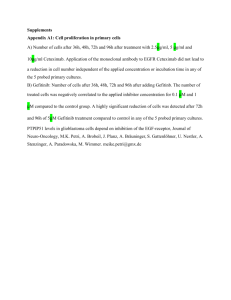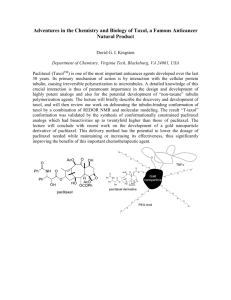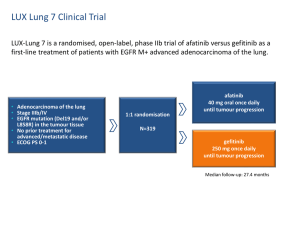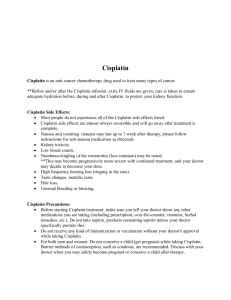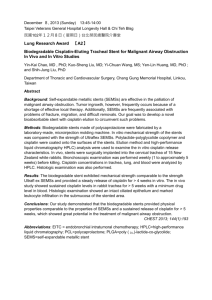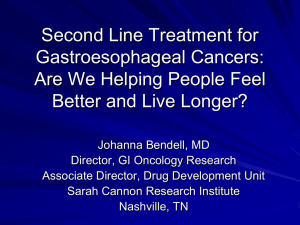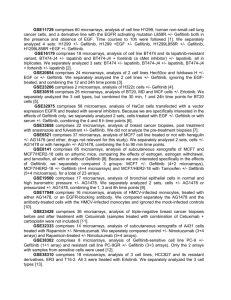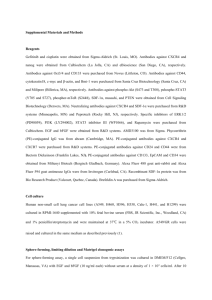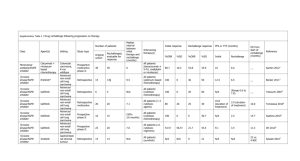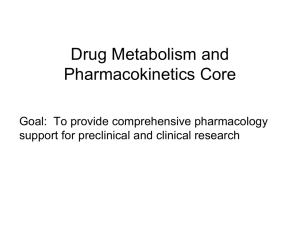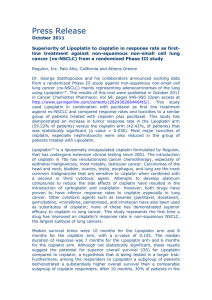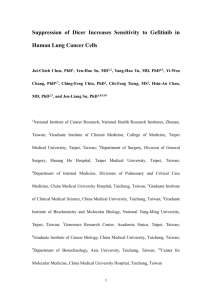Antagonism Between Gefitinib and Cisplatin in Non-Small
advertisement
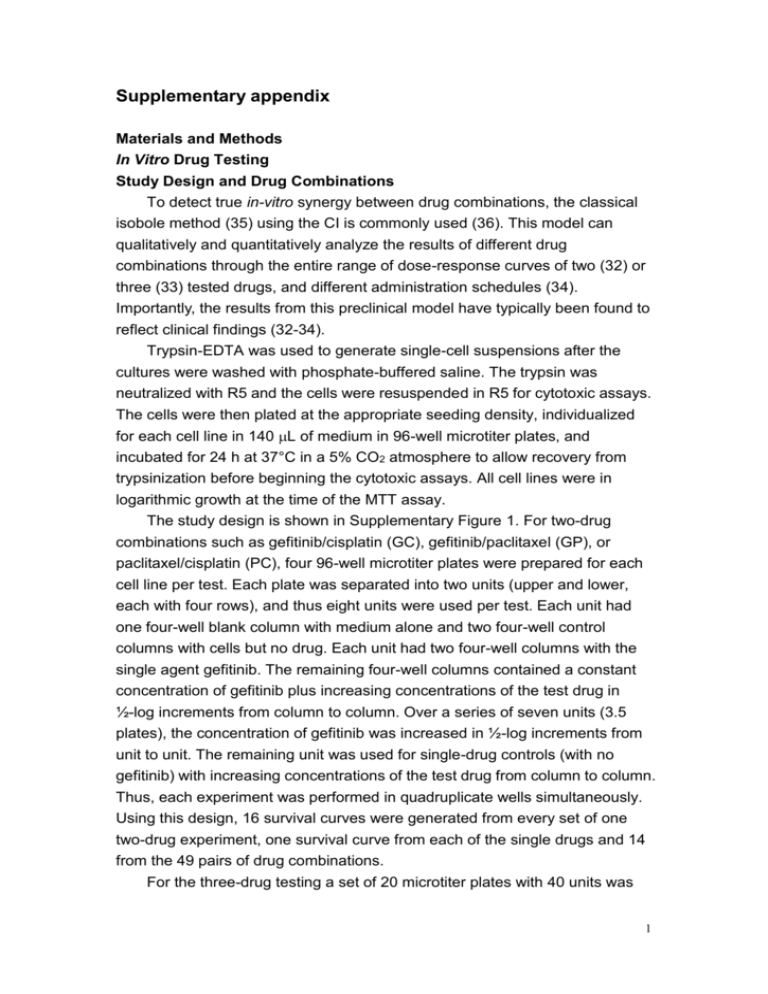
Supplementary appendix Materials and Methods In Vitro Drug Testing Study Design and Drug Combinations To detect true in-vitro synergy between drug combinations, the classical isobole method (35) using the CI is commonly used (36). This model can qualitatively and quantitatively analyze the results of different drug combinations through the entire range of dose-response curves of two (32) or three (33) tested drugs, and different administration schedules (34). Importantly, the results from this preclinical model have typically been found to reflect clinical findings (32-34). Trypsin-EDTA was used to generate single-cell suspensions after the cultures were washed with phosphate-buffered saline. The trypsin was neutralized with R5 and the cells were resuspended in R5 for cytotoxic assays. The cells were then plated at the appropriate seeding density, individualized for each cell line in 140 L of medium in 96-well microtiter plates, and incubated for 24 h at 37°C in a 5% CO2 atmosphere to allow recovery from trypsinization before beginning the cytotoxic assays. All cell lines were in logarithmic growth at the time of the MTT assay. The study design is shown in Supplementary Figure 1. For two-drug combinations such as gefitinib/cisplatin (GC), gefitinib/paclitaxel (GP), or paclitaxel/cisplatin (PC), four 96-well microtiter plates were prepared for each cell line per test. Each plate was separated into two units (upper and lower, each with four rows), and thus eight units were used per test. Each unit had one four-well blank column with medium alone and two four-well control columns with cells but no drug. Each unit had two four-well columns with the single agent gefitinib. The remaining four-well columns contained a constant concentration of gefitinib plus increasing concentrations of the test drug in ½-log increments from column to column. Over a series of seven units (3.5 plates), the concentration of gefitinib was increased in ½-log increments from unit to unit. The remaining unit was used for single-drug controls (with no gefitinib) with increasing concentrations of the test drug from column to column. Thus, each experiment was performed in quadruplicate wells simultaneously. Using this design, 16 survival curves were generated from every set of one two-drug experiment, one survival curve from each of the single drugs and 14 from the 49 pairs of drug combinations. For the three-drug testing a set of 20 microtiter plates with 40 units was 1 prepared for each cell line. There was a four-plate subset for each GC, GP, and PC combination. The study design of these subsets was the same as that of the two-drug combination described above. The remaining eight plates were defined as the paclitaxel/cisplatin/gefitinib (PCG) group and were divided into two four-plate subsets for testing two fixed (low and high) concentrations of gefitinib. Each subset tested only the low or high gefitinib concentration. In addition to adding gefitinib into every test well, the only exception in PCG (compared with PC) plates was that they had one four-well GC column and reserved one four-well single gefitinib column, instead of two four-well GC columns. With this design, 73 survival curves were generated from each experiment: one from each of the three single agents, 14 from each of the three two-drug combinations, and 14 from each of the two PCG groups of different gefitinib doses. The day after the cells were plated into the microtiter wells, medium and drugs were added as follows: R5 (60 L) was added to no-drug control wells, 40 L of R5 and 20 L of drug were added to single-drug wells (paclitaxel, cisplatin, gefitinib), 20 L of R5 and 20 L of each drug were added to two-drug combination wells (GC, GP, PC), and 20 L of each drug were added to three-drug combination wells (PCG). Chemotherapeutic agent was added 20 min before gefitinib for gefitinib-drug combinations, and cisplatin followed by gefitinib or cisplatin was added 20 min after administration of paclitaxel for PCG or PC combinations. The Combination Index After the addition of drugs, the microtiter plates were incubated for 96 h. Cell survival was determined using the MTT colorimetric assay (34-36). The percentage of control absorbance was considered to be the surviving fraction of cells, and the IC50 values were defined as the concentrations of drug that produced a 50% reduction in control absorbance. For the single agents tested, the results reported as IC50 were the means of three independently performed assays, each in quadruplicate (or eight replicate) wells (Supplementary Figure 1). The combination index (CI) at the 50% effect level was defined as the sum of the relative doses of each drug that yielded an isoeffect (50% in this study) cell kill when added together, and was used to represent the combination effects of test drugs. Within the designed assay range, a set of CI values or data points was generated because there were multiple drug concentrations within the assay range that achieved the same isoeffect. 2 Supplementary Table 1. Results of single agent, two- and three-drug combination studies in three NSCLC cell lines* ____________________________________________________________________________________________________________________ Single agent IC50 (M) Gefitinib Cell line/ EGFR status Cisplatin Paclitaxel Two-drug combination Three-drug combination Mean combination index Mean combination index _______________________________ ____________________________________ _________________________ (G) (C) (P) GC GP PC PCGL PCGH ____________________________________________________________________________________________________________________ H23/wild Mean value 95% CI 10.68 4.72 0.0064 1.146 0.965 1.038 1.106 1.113 10.30, 11.05 4.56, 4.89 0.004, 0.009 1.053, 1.239 0.926, 1.004 1.005, 1.071 1.085, 1.127 1.053, 1.173 12 9 8 8 8 Number of data points Result† Antagonism Additivity Additivity Antagonism Antagonism ____________________________________________________________________________________________________________________ H3255/mutant Mean value 95% CI 0.0042 7.39 0.004, 0.004 6.72, 8.06 0.002 1.055 0.994 1.155 1.262 1.066 0.000, 0.004 1.016, 1.093 0.947, 1.040 1.039, 1.270 1.106, 1.419 0.985, 1.147 8 7 8 10 9 Number of data points Result† Antagonism Additivity Antagonism Antagonism Additivity ____________________________________________________________________________________________________________________ HCC827/mutant Mean value 95% CI Number of data points 0.0025 3.13 0.002, 0.003 0.46, 5.80 0.008 1.148 1.091 0.930 0.943 1.072 0.002, 0.014 1.030, 1.270 1.036, 1.146 0.898, 0.962 0.900, 0.986 1.013, 1.132 9 6 9 8 8 3 Result† Antagonism Antagonism Synergism Synergism Additivity ____________________________________________________________________________________________________________________ * GC: gefitinib + cisplatin; GP: gefitinib + paclitaxel; PC: paclitaxel + cisplatin; PCGL: paclitaxel + cisplatin + low dose gefitinib (1 M for wild-type EGFR cell lines H23, and 0.0003 M for activating-EGFR mutants H3255 and HCC827); PCGH: paclitaxel + cisplatin + high dose gefitinib (3 M for H23 and 0.0003 M for H3255 and HCC827). Data points were generated from mean values of three independently performed experiments. 95% CI, 95% confidence interval. † Sign test was applied to confirm the results. The results of statistic analyses of the differences between drug combinations are shown in Figure 2. 4 Supplementary Figure 1. Study design. Upper and lower panels show study designs for the two- and three-drug combinations, respectively (see text). B, Blank well with medium only; Co, control well with cells in the medium; G, gefitinib; C, cisplatin; GC, gefitinib/cisplatin; GP, gefitinib/paclitaxel; PC, paclitaxel/cisplatin; PCG, paclitaxel/cisplatin/gefitinib; 1-7 or a-g, seven drug concentrations with a ½-log increment. Each unit represents a half microtiter plate (four rows). G of the lower panel plates represents a fixed concentration of gefitinib in each four-plate subset. Supplementary Figure 2. Spearman’s correlation analysis of the mCI values and the sensitivity to gefitinib (Panel A), or cisplatin (Panel B) Supplementary Figure 3. Results of drug combinations in two selected cell lines, H3255 (Panel A) and HCC827 (Panel B). (a) log-dose-versus-response curves of the individual drugs, with seven concentrations in each (in ½-log increments for a 3-log range) to cover the entire curve whenever possible. GL and GH: high- and low-dose gefitinib selected for testing in the three-drug combination (see text). Mean IC50 values and 95% confidence intervals (error bars) calculated from the results of three independent assays performed in quadruplicate are shown. (b) to (f): isobolograms of gefitinib/cisplatin (GC), PC (paclitaxel/cisplatin), GP (gefitinib/paclitaxel), and PC plus low-dose (PCGL) or high-dose gefitinib (PCGH). Data points (see text), generated from mean survival fractions of three independent experiments performed in quadruplicate, above the dashed additive diagonal line (Add) in the isobole suggest antagonism (Ant) and those below the diagonal suggest synergism (Syn). Sign tests were applied to each set of data points to formally evaluate whether synergism or antagonism was evident for a particular cell line and drug combination. 5
